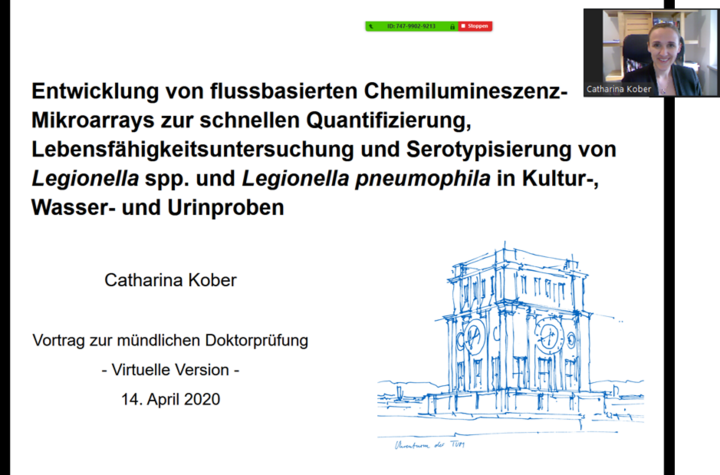„Development of flow-based chemiluminescence microarrays for the fast quantification, viable/nonviable-differentiation and serotyping of legionella in culture, water and urine samples“
Abstract
Within the last years, increasing numbers of legionellosis cases have shown that a sensitive, rapid and innovative method for the detection of Legionellae in water (e.g. surface water, drinking water, process water) and patients’ urine is still needed. Often legionellosis is caused by the species Legionella pneumophila (90%, L. pneumophila). The cultivation of clinical and environmental samples still represents the gold standard method for the detection of Legionella although it takes up to 10 days for results and only detection of culturable Legionella spp. is possible. Subsequently, further methods have to be applied in order to quantify and type obtained Legionella colonies.
The drinking water ordinance demands regular monitoring of tap water and based on the 42nd Federal Emission Control Act (42. BImSchV) condensation recooling plants, cooling towers and wet separators have to be registered and monitored since 2017. Therefore, it is important to quantify Legionella spp. and L. pneumophila in a culture-independent and rapid way. A chemiluminescence DNA microarray was established using the isothermal heterogeneous asymmetric recombinase polymerase amplification (haRPA) on the automated flow-based analysis platform MCR 3. The differentiation and quantification of L. pneumophila and Legionella spp. is carried out by amplification of the genomic sequences of mip and 16S rRNA genes, respectively. Detection limits of 26 genomic units (GU) µL−1 for L. pneumophila and 87 GU µL−1 for Legionella spp. were achieved. For viable/ non-viable-differentiation, for the monitoring of e.g. biocide effects, samples are treated with the DNA-intercalating dye propidium monoazide (PMA), which penetrates in non-intact cell membranes of non-viable microorganisms and intercalates into the DNA, thereby inhibiting subsequent amplification by haRPA. With the so-called viability haRPA, predefined proportions of viable Legionella spp. could be measured in a range from 101 - 105 GU µL-1 with recovery rates of 81 to 133%. By the combination of the haRPA and the viability haRPA, it is possible to substitute culture-based methods and improve the monitoring of engineered water systems such as condensation recooling plants and efficiency of biocides in the future.
In case of an outbreak situation caused by emissions of Legionella-containing aerosols, it is fundamental to rapidly align infected patients to the outbreak source in order to prevent further infections. For this reason, a chemiluminescence sandwich microarray immunoassay (CL-SMIA) for the detection and serotyping of L. pneumophila was established on the microarray analysis platform MCR-R. A rapid and multiplexed monoclonal subtyping of all subgroups of L. pneumophila serogroup (SG) 1 is possible with a panel of ten sensitive and selective antibodies within only 34 min. In application measurements 100% of the measured samples could be clearly assigned to SG 1, which shows comparable results to commercially available kits. Additionally, a direct and rapid comparison of patients’ urine samples with environmental water samples of putative outbreak sources can be done with the same method and on the same device. Furthermore, an assignment to Pontiac and Non-Pontiac group is possible in many cases as well as the subtyping of the Sg 1 subgroups in samples with higher concentrations. The CL-SMIA can be applied in various settings such as in clinical diagnostics and environmental hygiene monitoring of the health authorities to analyze patients’ urine samples as well as water samples. This allows the rapid exclusion of many environmental samples to focus on a smaller number of samples for genotyping during outbreak investigations.
